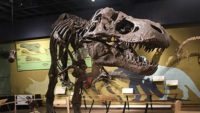Recently, after audio-recording underwater in Greenland’s fjords, two geoscientists published research on vocalizations made by narwhals. The sounds included shrill whistle tones, repetitive clicks, knocking sounds, buzzing noises, and even some tonal pulses inaudible to human ears.1,2 Complicating the situation, narwhals routinely summer near calving icebergs, so their natural surroundings are often noisy. More… …read more Source: icr.org
Evolution is often claimed to explain something and its opposite, so it certainly should not be called science, rather an unfalsifiable ideology! …read more Source: creation.com
Where are the small craters expected by the ‘billions of years’ framework on Pluto’s moon Charon? Read More
An amazing abundance of life can be found in the strangest places—such as the backs of turtles. It was previously known that an array of life was present on the backs of loggerhead sea turtles, and new research shows that it’s more abundant and diverse than scientists ever realized.1 An international group of researchers, headed up by Florida State University scientists, discovered more than double the total nu… More… …read more Source: icr.org
European dippers are making the news lately, including science news in Wales.1-3 These riparian habitat birds are indicators4 of freshwater stream quality, as noted below. Scientists study them to learn how badly freshwater streams are polluted—such as by non-biodegradable (non-decaying, indigestible) plastic waste products.2,3 Birds living on … More… …read more Source: icr.org
By Dr. Jennifer Hall Rivera The amazing design of fingerprints helps us get a good grasp on God’s Word. …read more Source: AIG Daily
Recent research surprises those who study coral reefs, especially those who assume that they grow slowly.1,2 To the surprise of old-earth evolutionists, these findings reveal that reef ages do not conflict with relatively young biblical chronology timeframes. New research at the University of Hawai?i at M?noa revealed unexpectedly high growth rates for deep water photos… More… …read more Source: icr.org
Recently reported research demonstrates how astonishingly helpful scales are to fish—such as the common carp (Cyprinus carpio), whose scales blend armor-like protection with flexibility needed for underwater mobility.1,2 The carp scales research is published in the journal Matter,1 and has been briefed in Science Daily.2 More… …read more Source: icr.org
By Dr. Nathaniel T. Jeanson How biblical timelines and modern genetics unveil a new understanding of people group identity and migration. …read more Source: AIG Daily
While searching for a missing plane on the ocean floor, scientists made an interesting geological discovery. On March 8, 2014, Malaysia Airlines flight MH330 disappeared with all 239 people on board somewhere over the southern Indian Ocean. So far, no pieces of the plane have ever been found on the ocean floor. From 2014 to 2016, three vessels collected detailed sonar images over a large piece of the Indian Ocean whi… More… …read more Source: icr.org
For the Chinese these huge creatures were not mythical. …read more Source: creation.com
Scientists recently discovered evidence that large theropods were possibly guilty of cannibalism.1 The new study, published in PLOS ONE, examined over 2,300 bones from the Mygatt-Moore Quarry in western Colorado.1 It was led by Stephanie Drumheller, from the Department of Earth and Planetary Sciences, the University of Tennessee, Knoxville, and several colleagues. The scientists determined that about … More… …read more Source: icr.org
A new analysis of thousands of deep earthquakes has revealed several large structures at the base of the mantle.1 Known as ultra-low velocity zones, these structures may give us better insight into the origins of hot spots which produced the Hawaiian Islands during the Flood year. Doyeon Kim from the University of Maryland and his colleagues analyzed over 6,000 shear (S-waves) waves from earthquakes deeper than … More… …read more Source: icr.org
A team of researchers used more than two million images obtained by NASA’s Lunar Reconnaissance Orbiter to construct the first near-global map of rockfalls on the moon. The map shows more than 136,000 rockfalls between 80° northern and southern latitudes on the lunar surface.1,2 Interestingly, the scientists—who were from ETH Zurich and the Max Planck Institute for Solar System Research—were surprised to find that… More… …read more Source: icr.org
An ancient city found deep in a Central American rainforest yields a surprising discovery. A recent BBC report earlier this month is revising assumptions about “Mosquito Coast” jungle biodiversity. The report covered ecoscience research conducted in tropical rainforests of Nicaragua and Honduras. Apparently some jungle creatures assumed to be regionally extinct—or even completely extinct—still survi… More… …read more Source: icr.org
Scientists from China, Sweden, and Australia have discovered what they claim is the oldest known parasite, publishing their results in Nature Communications.1 The evidence comes from small tube-shaped objects attached to the shells of the host brachiopods.2 Scientists speculate that these tubes contained some sort of parasitic worm. Parasites are “nutritionally dependent upon the host for at lea… More… …read more Source: icr.org
Under ideal circumstances, we can do a lot of good. But when circumstances handicap or restrict our potential—in ways we cannot circumvent—we just do the best that we can. That principle is true for humans as well as in the water-filtering services of the humble bivalves we call oysters—according to recent research involving the University of Maryland.1,2 Dr. Matthew Gray, an ecologist at… More… …read more Source: icr.org
In 2017, a large dinosaur was discovered washed out to sea,1 similar to the dinosaur bone found 70 miles off Norway’s coast.2 Only this one was partially intact, nearly perfectly preserved, and still contained its last meal fossilized inside its gut.1 Recently, a group led by paleontologists from the Royal Tyrrell Museum of Palaeontology examined the stomach contents of the dinosaur and reported their findin… More… …read more Source: icr.org
By Ken Ham If you were hunting for dinosaur footprints, it probably wouldn’t occur to you to look up—but that’s exactly where a team of researchers discovered a trackway of the footprints of a titanosaur (long-necked sauropod). In Southern France, researchers were crawling through a labyrinth of cave passages and discovered the prints, 1,640 feet underground. The researchers discovered 38 tracks, some of which were four feet long (now that’s one big dinosaur!), likely made by three of the giant creatures. The researchers discovered 38 tracks, some of which were four feet long (now that’s one big dinosaur!), likely made [More]
A recent attempt by European astronomers to use the Hubble Space Telescope to find evidence for the first stars expected by secular theory has failed. This is despite the Hubble Space Telescope’s ability to image objects at vast distances—so vast that these objects were supposedly formed 500 million years after the alleged Big Bang.1-3 Astronomers classify stars into three populations, or groups, according to… More… …read more Source: icr.org
The very first tapejarid pterosaur identified in the United Kingdom was recently found on the Isle of Wight along the southern coast of England.1 But the discovery also raises some questions that are uncomfortable for uniformitarian scientists. Tapejarids are extinct flying reptiles that have “elaborate soft tissue head crests” and a few other anatomical differences from other pterosaurs.1 More… …read more Source: icr.org
By Troy Lacey Reexamining the evidence for Tyrannosaurus rex on being fast or slow, hunting in packs or alone, using the latest research with a biblical perspective. …read more Source: AIG Daily
A new book on tree rings—Valerie Trouet’s Tree Story—blends some serious tree science with some uniformitarian mythology. The book is being heavily promoted by Johns Hopkins University.1 Aimed at young readers, it will indoctrinate children into the same old mythology about trees, implying that tree ages can be determined by counting growth rings.1,3 … More… …read more Source: icr.org
Many people are aware that our digestive tract is full of beneficial bacteria that not only help us process our food, but also support a strong immune system. Now, a new research study has just been published showing the importance of healthy bacteria in the respiratory system of our nose and upper sinuses.1 Beneficial types of bacteria living in our digestive system, genital tracts, and on our skin have been proven to p… More… …read more Source: icr.org
Various water-striding insects use small body sizes, long legs, and fine hairs on their feet to skate on the surfaces of ponds and streams. But life on the open ocean presents tougher challenges than landlocked waterways. Waves, fishes, salt, and birds should spell disaster for such small striders. Only one genus, Halobates, has cracked the ocean code, and new research names the necessary creature features. Scientists from… More… …read more Source: icr.org
Can they form in moving water, consistent with Noah’s Flood? …read more Source: creation.com













































